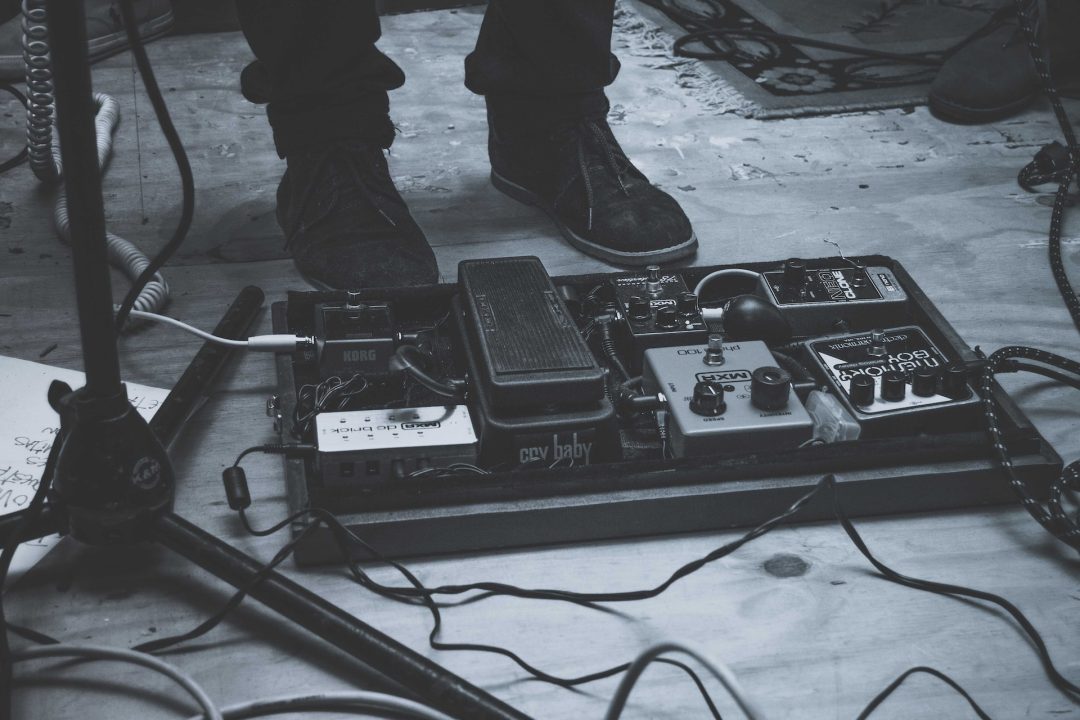Rarely is an effect quite as recognizable to the masses as the venerated wah. From Frank Zappa to Jimi Hendrix to Eric Clapton, and from Tony Iommi to Tom Morello to Kirk Hammett, many of the world’s most famous guitarists have employed the iconic effect to some degree in their sound. Chances are your board needs one if you’re visiting today, so here are several of our favorite flavors.
What Is a Wah Pedal?
A wah is an electronic simulation of a brass mute that trumpet and trombone players started using frequently in the 1920s. When you mute a brass instrument’s bell, moving it back and forth, the sound becomes vocal and mimics a sort of “crying” sound, hence the onomatopoeic phrase, “wah-wah.”
Vox engineers accidentally stumbled upon the effect while designing the solid-state Vox Super Beatle amp for US markets in 1966. The amplifier was meant to be a more affordable version of the AC50, which the Beatles had popularized in the day. The Super Beatle included a few built-in effects, including reverb and — in retrospect, most importantly — a Mid Resonant Boost (MRB). A happy accident occurred when the design team realized they could sweep the MRB frequency using a Vox Continental volume pedal. It sounded like a brass mute, and the wah was inadvertently born.
How Does Wah Work?
Wah is a simple effect overall. In essence, it consists of a shiftable band-pass filter with a big resonant peak frequency. Users can typically set a center frequency, then sweep back and forth between lower and higher frequencies using the foot rocker. Down at the heel side are the lower frequencies, and the toe side, higher frequencies. Players also sometimes leave the pedal “cocked,” so it engages the filter and the peak frequency for a cool effect without the dynamic, shifting “wacka” sound.
Tips for Using Your Wah Pedal to Nail Your Sound
Apart from the center frequency, some more advanced pedals give you the option to set the range and bandwidth of frequencies. These definitely help further refine and shape the tone of the pedal, but they aren’t standard features in every wah.
- RELATED: The 7 Best Chorus Pedals for Your Board
- RELATED: The 10 Best Overdrive Pedals for Guitar
- RELATED: The 10 Best Fuzz Pedals to Add Some Serious Crunch to Your Sound
Perhaps the most important consideration when choosing the best wah pedal for you, then, is the manufacturer’s specific voicing. This is an intangible that’s built into the pedal itself, so once you’ve narrowed down a few options, it’s a good idea to review some demos to hear their individual characteristics.
The 7 Best Wah Pedals for Your Pedalboard
1. Dunlop Cry Baby Mini 535Q – Best Overall
Dunlop’s Cry Baby is one of the most widely used wah pedals around. Containing all of the flexility and power in a mini enclosure, the 535Q slides easily into any existing pedalboard without commanding a huge amount of real estate. Adjustable parameters include bandwidth (Q), frequency range, and an onboard boost to slice through a mix.
2. Vox V845 Classic Wah Pedal
Vox invented the wah, and even though it was an accident, there’s certifiable pedigree when you decide to purchase a modern-day Vox wah pedal. This one in particular nails those classic ’60s tones, a la Clapton and Hendrix and many other legends. There aren’t many moving parts on this one, but the sound is iconic and the price is right as well.
3. Electro-Harmonix Wailer Wah
EHX’s Wailer contains the same circuitry as the company’s popular Crying Tone wah. It makes for a great gigging pedal because the enclosure is made of a highly durable polymer that reduces weight by at least a few pounds. The sound is vowel-esque and sweeps evenly across the frequency range; cocked tones are fantastic, too.
4. Jim Dunlop Cry Baby GCB95 Wah Pedal
The GCB95 by Dunlop is thee go-to standard wah pedal for many guitar players. Similar to the Vox pedal above, this is the original Cry Baby used by countless players through the ages, including Hendrix, Clapton, and David Gilmour. Not only is the sound timeless, but this thing could survive a nuclear fallout with its insanely rugged enclosure.
5. Boss PW-3 Wah Pedal
What sets the Boss PW-3 apart from other wah pedals is its voice switch that lets players swap between vintage or modern tones. This gives guitarists the choice between two distinct styles in a single pedal. Other than that, this is a streamlined design that’s pedalboard friendly and extremely durable to withstand the rigors of the road (or simply impassioned wah-wahing).
6. Morley Steve Vai Bad Horsie 2 Contour Wah
While there are hundreds of guitar players throughout history revered for their innovations on the instrument, few share the same space as names like Steve Vai. His virtuosity was (and is) groundbreaking, inspiring generations of guitarists who have followed since. The Bad Horsie wah contains Vai’s signature wah sound, plus a host of other features making it a versatile effect.
7. Electro-Harmonix Cock Fight
The Cock Fight by EHX is three effects in one. It has two filter styles for regular wah sounds as well as “talking” wah tones. From there, it includes a fuzz circuit that you can engage either before or after the wah filter for two additional distinct sounds. This is an incredibly versatile and expressive wah that players can coax a ton of variety from.
